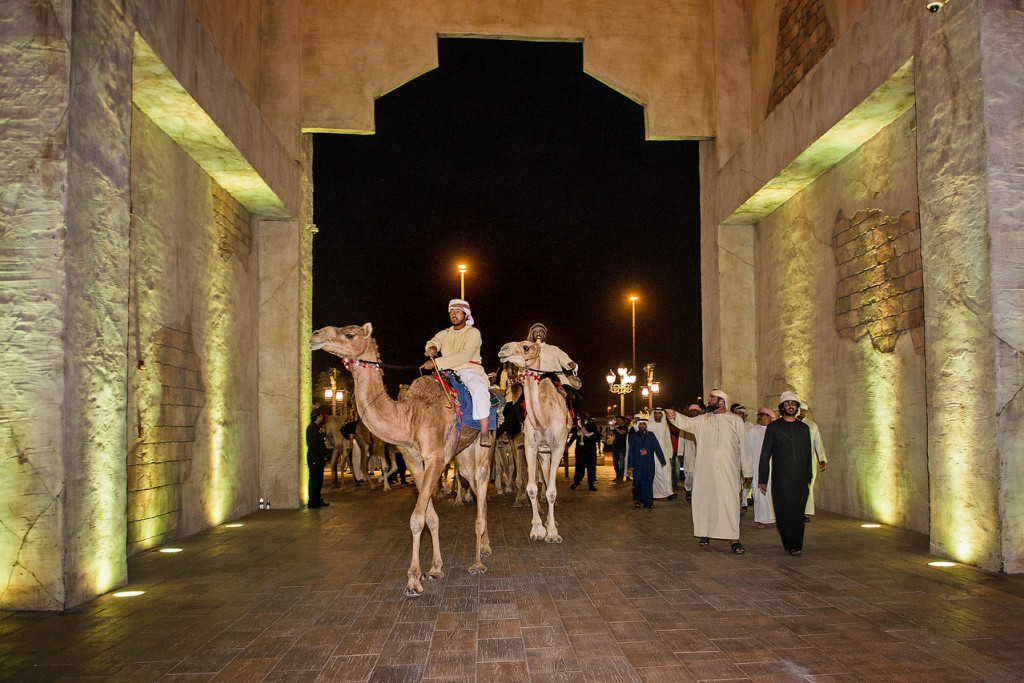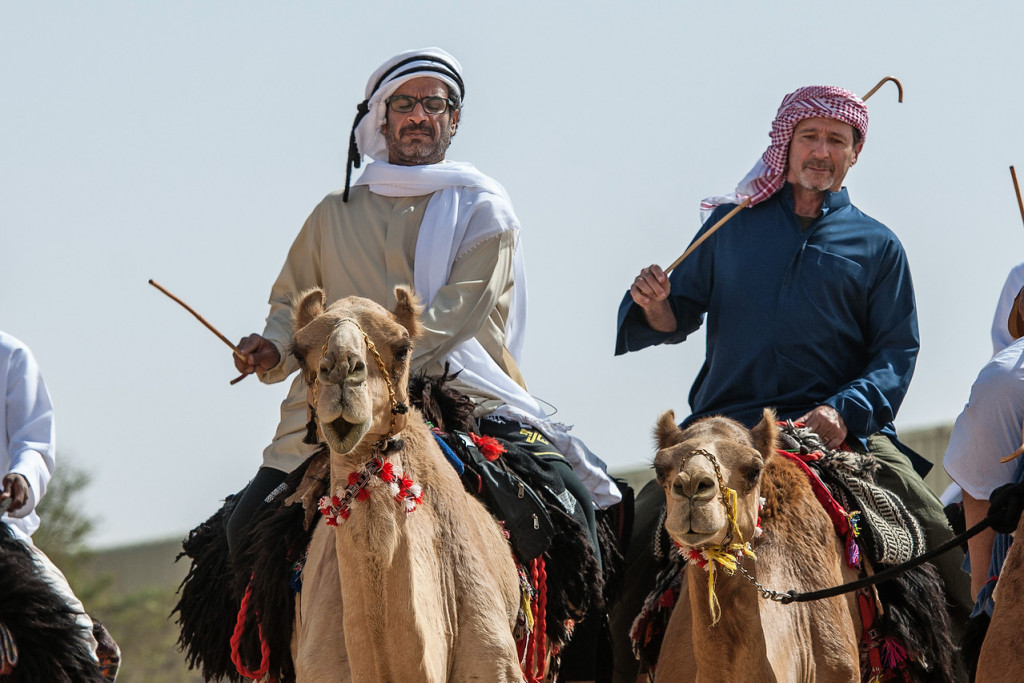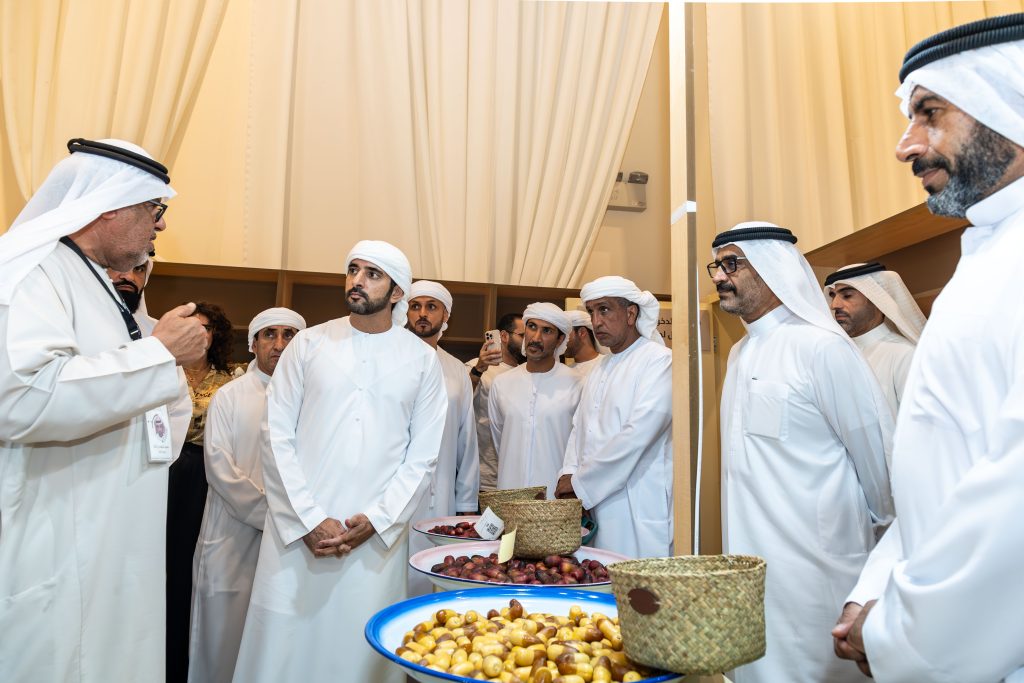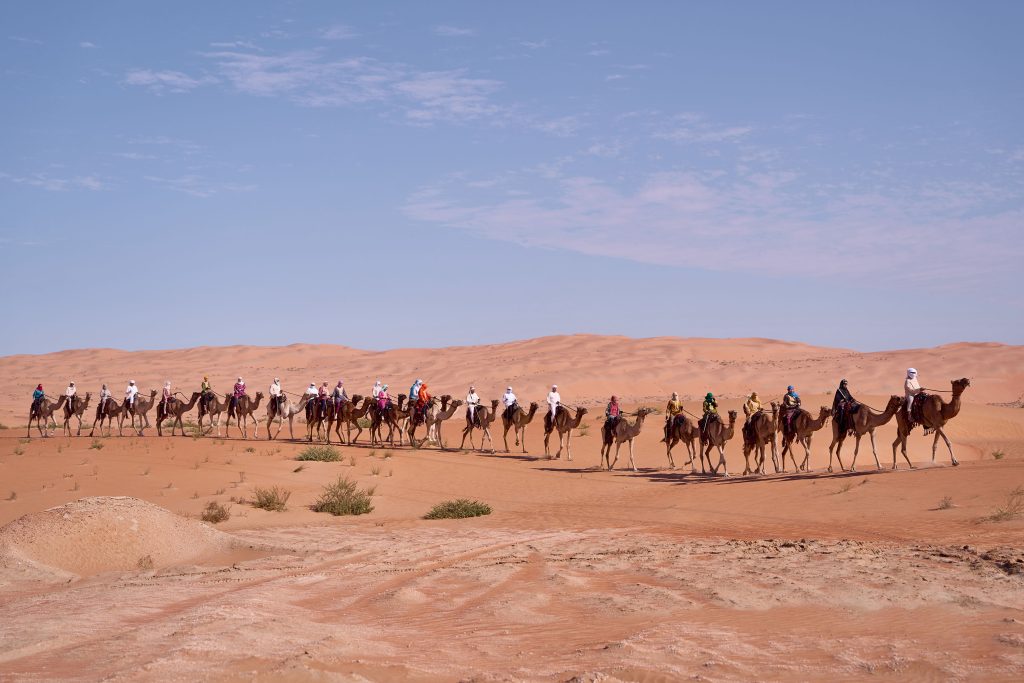DUBAI, 28th January 2018: There was a sense of triumph as the participants in the fourth edition of the ‘Camel Trek’ organized by Hamdan Bin Mohammed Heritage Center (HHC) returned after successfully completing the longest journey across the desert of the UAE which began from ‘Empty Quarter’ in Abu Dhabi on 17th January, 2018 and ended at Global Village in Dubai on Saturday 27th January.
The camel caravan comprising 15 participants, including six women, from diverse cultures arrived majestically just after dusk in an orderly manner to the amazement of onlookers and were welcomed like heroes during the special ceremony held at the Heritage Village.
The trekkers spent 11 days in the desert travelling over 500 kilometres just like how people traversed on the ‘ships of the desert’ more than 70 years ago and eagerly related their experiences after tracing back the footsteps of the past and living in co-existence with other nationalities.
Longest
His Excellency Abdullah Hamdan Bin Dalmook, CEO of HHC, said: “This is the longest version of our annual ‘Camel Trek’. There were many challenges, but we were able to follow the map of the trek that was prepared after embarking on pre-exploratory excursions to chart our route. We must face difficulties to revive a culture that benefits the participants who wanted to experience life in the past. For the first time, we travelled more than 63 kilometers on the camel’s back in one day. This distance is a record because today it is not easy to achieve.”
“This is a rare experience that enhances the nature of belonging and adds a culture of recognition and coexistence with other nationalities. We look forward to opening the doors to a larger number of citizens in the future to benefit from this meaningful experience and we hope that other specialized institutions in the revival of heritage will organize such cultural treks’” he added.
Cultural
The Argentinean Ambassador to the country, Fernando de Martini, who joined the ‘Camel Trek’ during the last four days, said: “The journey I experienced for the first time in my life embodied my beliefs that human and cultural similarities between the two nations: Argentine and the UAE. I joined the trip after hearing about it because I believe that the best way to know about the cultural dimension of any country is to be part of its literary, heritage and history. I am happy to know the authentic Emirati personality through the ‘Camel Trek’ leader and other participants representing many countries.”
Popular
Hind Bin Demaithan Al Qemzi, Director of Events at HHC, welcomed the participants in this annual journey which has become popular and thanked all the participants whom she considered to be partners in the march that promotes national identity and contributes to the dissemination of UAE heritage.
The camel caravan comprising participants from the United Arab Emirates, Oman, United Kingdom, France, Algeria, Syria, Pakistan, Malaysia, Ukraine and Argentina, were treated to an exhibition of traditional dances by an Emirati dance troupe and as part of a time-honoured tradition, saffron was put on the faces of camels.
The ‘Desert Knights’ of the 2018 ‘Camel Trek’ were profuse in praise of the HHC for organizing this annual event which has given them a rare opportunity to embrace the unique culture and beautiful landscape of the UAE and HE Bin Dalmook for being a guiding inspiration during their challenging journey especially through some of the most rugged terrain.
Vacation
“It was amazing… unbelievable… the best vacation in my life,” exclaimed 30-year-old Ukrainian Mila Kladova who cancelled her vacation to Italy to join the ‘Camel Trek’ for the first time.
“Firstly I want to thank the organizers HHC and our leader Abdullah Hamdan (Bin Dalmook). He is an unbelievable person. When we were kind of weak, he gave us inspiration,” said Mila who has become a stronger as an individual after the experience.
“By nature we as women are weak but after this trip I believe whatever goal I have in mind, I can achieve it,” said Mila who was amazed by the ‘Empty Quarter’.
“Oh my goodness it was unbelievable. I saw dunes about 300 meters high. The sunset and sunrise was unbelievable. I just enjoyed each day, each moment,” said Mila who calls herself a ‘Ukrainian Bedouin’.
Dunes
Charlotte Sarrazin was “just tired” after completing her third successive ‘Camel Trek’ but vowed to return next year as well.
“The dunes and landscape were completely different. We didn’t see anything for four days. We just saw a straight line when we trekked along the UAE-Saudi Arabia border. When I will look at the map now, I can’t imagine that we crossed all of this,” said Charlotte who lauded the leadership given by HE Abdullah Hamdan Bin Dalmook.
“Every year we had different leaders. This year with Abdullah Hamdan (Bin Dalmook) it was challenging and interesting. He really trusted us and made us rely on ourselves. He asked us to do some formations with the camels. We did much more kilometers, there were much more stories and we crossed over 500 kilometers easily,” said Charlotte.
Tough
Her French compatriot Anne-Laure Laine, also completing the ‘Camel Trek’ for the third year, said it was tougher than before.
“It was tougher because there were more long distances and new places,” she said enjoying the beauty of the ‘Empty Quarter’.
“The landscape is the same but it was beautiful. It is very satisfying to see all the distance we did with the camel,” said Anne who was also pleased to ride her camel alone for the first time on the trek.
City
Nicola Mather, a British mother of two teenaged children, enjoyed every moment of the extraordinary trek despite the physical challenges.
“There were lots of physical challenges for everybody irrespective of age. Every morning getting up with the tiredness in the body which has not recovered from the day before and you have to ride another 50 kilometers and more,” said Nicola who felt the ‘Empty Quarter’ did not pose as much a challenge as returning to the city.
“One of the most challenging bits was coming back to Global Village with all the lights and noise. Camels really don’t like that. In all the other parts of UAE it was just beautiful, the natural environment for the camels,” said Nicola who treasures many wonderful memories of her maiden ‘Camel Trek’.
“I really enjoyed the group that I was with. We had a great bunch of people and we generally got on extremely well. I loved sitting around the camp fire at nights. I loved the satisfaction of having achieved 50 kilometers a day on a camel. I liked the peace and quiet of the desert. I loved the stars and hearing all the stories from Abdullah Hamdan (Bin Dalmook) who organized this trip and related stories about life 70 years ago when people rode camels every day before cars,” she said.
Route
Malaysian Muhamad Al Fansouri said it was his second time but on a different route.
“The challenge we faced was on day three of the trek when we had to trot almost 70 kilometers non-stop. What I learnt is basically to explore UAE from the other part. Last time we reached the Oman border this time the southern part of UAE. It is not easy to get riding a camel to explore the UAE,” he said.
Fun
Abdullah Malek, a 21-year-old medical student, said “it was really a great experience” after taking part in the ‘Camel Trek’ for the first time.
“It was as much tiring but so much fun. We learnt a lot of new skills. We learnt how to ride camels,” said Malek who wanted to explore new cultures.
“We learnt how to deal with camels, ride camels, how to survive in the desert. We wouldn’t have learnt other than by actually living the moment and living in the desert and trying to figure out how to actually get through the day in the desert. If I had the chance I would do it every single year,” said Abdullah who said going through the ‘Empty Quarter’ was “certainly a different experience”.
Ancestors
Algerian Fatima Khiran who famously switched off her mobile during her days on the ‘Camel Trek’ seriously wants to live the way her ancestors in the desert.
“It was fantastic. Only challenge we faced is the weather. Not only the cold weather in the morning but heat in the afternoon. It was exhausting as any trip but we really enjoyed. Ofcourse I would do it again,” said the 25-year-old who managed to live the way her grandparents did.
“Even though I had basic knowledge about camel I learnt a lot on this ‘Camel Trek’. How to handle them in the middle of nowhere, how to live without any technology and without what you are living now seriously,” said Fatima who is in love with the nature after enjoying its beauty in the ‘Empty Quarter’.
“It’s nice. You really can see the sky at night and in the day also. I will do it again and again. I want to stop living the modern-day life and turn back the clock,” said Fatima, a descendant from Bedouin origins.
“Learning about different cultures and nationalities, cooperating with the rest of the group, and training them based on my camel riding experience, I also learned from them,” said Ahmed Al Kalbani. “I hope to return and participate in the upcoming editions. I will miss all the participants and this trek will last in memory for a long time.”
Notes to editors:
Camel Caravan
The riders are trained to travel within the camel train or caravan, to move in a single line from one place to another according to the route plan which is prepared in advance by a competent team and the leader of the caravan, and have to satisfy certain criteria that would make them eligible to participate in the arduous trek.
A camel train or caravan is a series of camels carrying passengers and/or goods on a regular or semi-regular service between points. Although they rarely travelled faster than the walking speed of a man, camels’ ability to withstand harsh conditions made them ideal for communication and trade in the desert areas of North Africa and the Arabian Peninsula for centuries, though they could only travel on routes with sufficient sources of food and water.







